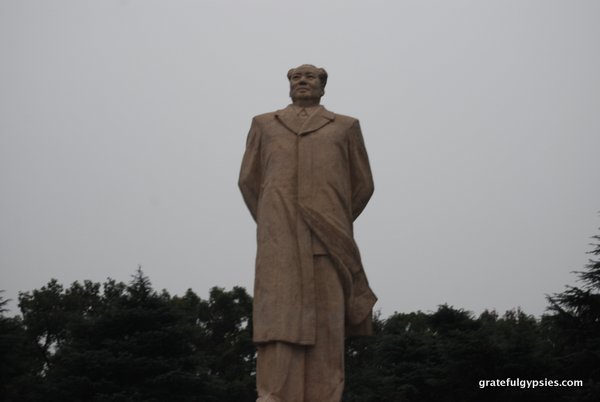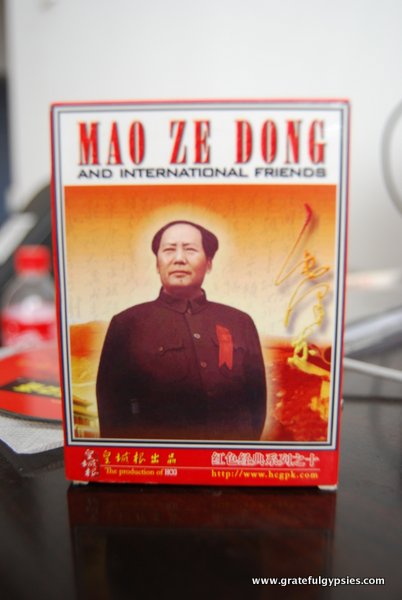All About Chairman Mao Posted by sasha on Mar 11, 2019 in Culture
It’s been over 40 years since Mao Zedong (毛泽东 – máo zé dōng) passed away, but he remains a very important figure in China to this very day. While the China of 2019 would certainly be unrecognizable to Chairman Mao (people driving Audis, drinking Starbucks, and eating KFC), he is still ever-present in the modern Chinese society. After all, it is his face that graces the Gate of Heavenly Peace and the front of all of the RMB notes. Love him or hate him, you can’t deny Mao’s importance in world history.
I’ve written a lot about Chairman Mao on the blog over the years, as I was always interested to learn more about him, his policies, and their effect on China and the world at large. Here’s a recap of all the Mao-related posts, with links to each one so you can read further.
From Birth to the PRC
In this post, you’ll learn about Mao’s early life up until he founded the modern-day People’s Republic of China (中华人民共和国 – zhōng huá rén mín gòng hé guó). Some facts may surprise you. For example, did you know that Mao began his time in Beijing as a library assistant sharing a crowded room with seven other people? Or that his first wife was executed by the Kuomintang? Read on to learn more!
Early Years of the PRC
On October 1st, 1949, Mao Zedong stood in Tiananmen Square and proclaimed: “The Chinese people have stood up!” (中国人民站起来了 – zhōng guó rén mín zhàn qǐ lái le). From that day on, he would be known as Chairman Mao (毛主席 – máo zhǔ xí). In this post, you can read all about those first pivotal years of the PRC, including Mao’s humiliating meeting with Joseph Stalin and the reforms he enacted to redistribute land to the peasants who supported him.
Hundred Flowers and Anti-Rightist Movements
In 1956, Mao started the Hundred Flowers Campaign (百花运动 – bǎi huā yùn dòng), which encouraged citizens to criticize the government. The name actually comes from a famous Chinese poem:
百花齐放,百家争鸣
bǎi huā qí fàng, bǎi jiā zhēng míng
“Let a hundred flowers bloom; let a hundred schools of thought contend.”
As it turns out, Mao didn’t take to the criticism very well. He made an abrupt change of face the following year and launched the Anti-Rightist Movement (反右派运动 – fǎn yòu pài yùn dòng) to silence his critics. You can learn all about both of these and the impact they had on Chinese society in this post.
Great Leap Forward
Chairman Mao had big plans for the new China, which he hoped would become a modern, industrialized nation that could rival the US. He enacted major changes as part of the country’s 5-year plan from 1958 to 1963, which became known as the Great Leap Forward (大跃进 – dà yuè jìn). His plan turned out to not be so great after all, and was instead rather disastrous. Head to the post to find out why and what happened as a result.
Cultural Revolution
After the catastrophic failure of his Great Leap Forward, Mao resigned as the State Chairman. For a while there, it seemed as if he was going to step to the side of Chinese politics. He was still very popular, though, and was basically just biding his time thinking of a new plan. That plan turned out to spur the Cultural Revolution (文化大革命 – wén huà dà gé mìng). He targeted “counter-revolutionary revisionists” in the government and had them purged. He also had schools shut down and turned the Chinese youth into his Red Guards (红卫兵 – hóng wèi bīng). With this army of young, impressionable people on his side, he set about destroying the “Four Olds” (四旧 – sì jiù) – old customs, old culture, old habits, and old ideas. Once again, Mao’s ideas turned out to be incredibly disastrous for the country. Read all about the Cultural Revolution by following the link to the post.
Chairman Mao’s Little Red Book
In souvenir markets all across China today, you can still buy copies of Chairman Mao’s “Little Red Book.” Officially known as “Quotations from Chairman Mao” ( 毛主席语录 – máo zhǔ xí yǔ lù), this is one of the most printed books in history. As a matter of fact, only the bible has been printed more! If you look at propaganda posters from this time period, almost every person in them is clutching their copy of Mao’s little red book. The book covers 33 topics with over 400 quotes from Chairman Mao, including:
“Political power grows out of the barrel of the gun.”
枪杆子里面出政权
qiāng gǎn zi lǐmiàn chū zhèng quán
Head to the post to learn more about the little red book and read some of the more famous quotes that are in it.
Later Years
There’s no denying that Chairman Mao was and remains a controversial figure. While most people in the west regard him as a brutal dictator, he is still beloved in China for uniting the country after the Japanese invasion and a long and bloody civil war. After his disastrous policies of the Great Leap Forward and Cultural Revolution, Mao had one more big surprise up his sleeve in his later years – bringing a US president to China for the first time ever. Nixon (尼克松 – ní kè sōng) traveled to China in 1972 to meet with Mao, which began the normalization of relations between the two countries. You can read all about their meeting as well as the final years of Mao’s life in this last post in the series.
Although Mao Zedong had wished to be cremated, his wishes were ignored. Instead, his body was embalmed and a mausoleum was constructed in Tiananmen Square to house it. His final resting place is the Chairman Mao Memorial Hall (毛主席纪念堂 – máo zhǔxí jì niàn táng), which is visited by thousands of people a day. They line up to buy plastic flowers, which are then collected and re-sold to the next group. It’s a bit ironic, as some believe that the body itself is in fact a wax replica.
It’s hard to wrap your head around Chairman Mao and his role in the history of both China and the world at large. While many of his policies were absolutely catastrophic, he remains somewhat of a deity in Chinese culture. Although his policies during the Great Leap Forward and Cultural Revolution likely set China back several decades, he also opened up relations with the US. It’s hard to imagine where the world would be today if Mao and Nixon hadn’t met a few decades ago.
I hope you found this series on Chairman Mao insightful and interesting. I sure enjoyed the many hours I spent researching and writing it. If you have any thoughts or questions, please feel free to leave a comment below.

Build vocabulary, practice pronunciation, and more with Transparent Language Online. Available anytime, anywhere, on any device.









Comments:
bokhari:
on book you have shown
mao ze tung
1893 to 1967
no its
1976
he died on
9th sept 1976
zhou en lai
on
8jan 1976
sasha:
@bokhari You are right! Thanks for the comment. My roommate bought that poster when I lived in Beijing many years ago and I never stopped to realize that it had the wrong date on it! That’s how you know it was a bad fake one. I replaced it with a different image to avoid confusion. Thanks for catching it!